SAN ANTONIO, Texas — High oleic canola is getting another year of reprieve from facing full-on competition from high oleic soybeans.
The original goal of the U.S. soybean industry was to have commercial introduction of two high oleic soybean traits in 2014. That will not happen until 2018 at the earliest because of regulatory delays.
Monsanto is still awaiting approval of its Vistive Gold soybeans in China, while DuPont Pioneer is in the ninth year of the European Union approval process for its Plenish soybeans.
DuPont is doing a limited launch of Plenish soybeans in regions of certain states where crush plants are selling the meal locally rather than shipping it to overseas markets.
Read Also

Volatile temperatures expected for this winter
DTN is forecasting a lot of temperature variability in the Canadian Prairies this winter. Precipitation should be close to average.
Monsanto is taking a more cautious approach with its Vistive Gold beans because 30 percent of the U.S. soybean crop is shipped to China, and the company does not want to risk contaminating shipments with an unapproved crop.
“It’s a pretty big liability thing,” said Mark Winkle, senior director of U.S. domestic programs with the United Soybean Board.
He is forecasting 650,000 to 700,000 acres of high oleic soybean acres this year, up from 450,000 acres last year. It will be almost entirely Plenish soybeans.
“It’s not big acres yet,” he said.
Winkle anticipates both companies will receive the remaining approval they require from China or the European Union by the end of 2017 or early 2018.
That would pave the way for full commercialization of both products in 2018, at which point the U.S. soybean industry can start winning back market share it lost to high oleic canola oil from Canada because of trans-fat labelling laws.
U.S. soybean farmers lost an estimated 1.8 billion kilograms of annual soybean oil demand because of trans-fat labelling. A decision by the U.S. Food and Drug Administration to phase out partially hydrogenated oil could mean another 680 million kg of lost demand.
The United Soybean Board has established a target of having 18 million acres of high oleic soybeans by 2023 producing four billion kg of oil.
Winkle said the acre and production targets are still valid, but the timeline might have to be pushed back a couple of years because of the regulatory delays.
If the acreage target is achieved, high oleic soybeans would be the fourth largest crop in the U.S. behind corn, commodity soybeans and wheat.
Mike Beard, a farmer from Frankfort, Indiana, has been growing Plenish soybeans for three years. He said they always out-yield his commodity soybeans.
He receives a 50 cent per bushel premium for growing the crop and keeping it identity preserved.
“This is not near as difficult an identity preservation as it is with a seed bean. It’s a better deal actually,” Beard said during an interview at the 2017 Commodity Classic conference in San Antonio.
He grows Plenish under contract with a local processor. The contracting program was filled almost as soon as it opened.
“There has been good acceptance in my area by farmers,” said Beard.
Winkle said that has been the case wherever Plenish beans are sold.
Beard said farmers are eager to grow high oleic soybeans to win back the market share that has been lost to healthier oil.
“I’m extremely excited to see this crop being grown in a volume that will allow our customers to experience this new oil and the advantages it has,” he said.
















